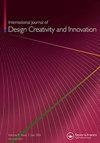草图和原型设计在早期产品设计中的相互作用
IF 2.5
Q4 ENGINEERING, MANUFACTURING
International Journal of Design Creativity and Innovation
Pub Date : 2018-01-30
DOI:10.1080/21650349.2018.1429318
引用次数: 19
摘要
摘要研究表明,对于简单机构的设计,草图和原型设计在一定程度上是可互换的,因为它们对想法数量和质量的影响。本研究探讨了这种互换性是否适用于消费品设计活动。比较了三种情况:仅绘制草图、仅绘制原型以及自由绘制原型和草图。18名新手设计师参加了一个小时的个人设计活动。设计专家和潜在用户对他们的设计理念进行了评估。提出了一种设计评估指标,即理念距离,以衡量设计空间探索的广度和深度。结果表明,平均而言,只画草图的人会产生更多的想法,探索更广阔的设计空间,并有更多新颖的最终设计。然而,被允许绘制草图和构建原型的参与者对设计空间进行了更深入的探索,并倾向于产生更具创造性的最终想法。只进行原型设计的个人生成的设计在美学上更令人愉悦,在功能上表现更好。探索更广阔的设计空间被发现与更独特的想法相关。然而,探索过宽的设计空间会降低创意探索的深度,并与最终设计的功能性能产生负面影响。本文章由计算机程序翻译,如有差异,请以英文原文为准。
Interplay of sketching & prototyping in early stage product design
Abstract Research suggests that, for the design of simple mechanisms, sketching and prototyping are somewhat interchangeable in terms of their influence on idea quantity and quality. This study explores whether this interchangeability holds true for a consumer product design activity. Three conditions are compared: sketching only, prototyping only, and free prototyping & sketching. Eighteen novice designers participated in a one-hour individual design activity. Their resulting design ideas were evaluated by both design experts and potential users. A design evaluation metric, idea distance, is proposed to measure the breadth and depth of design space exploration. Results showed that individuals who only sketched, on average, generated more ideas, explored broader design space, and had more novel final designs. However, participants who were allowed to both sketch and build prototypes explored the design space in more depth and tended to have final ideas that were perceived as more creative. Individuals who only prototyped generated designs that were perceived to be aesthetically more pleasing and performed better functionally. Exploring broader design space was found to correlate with more unique ideas. However, exploring too broad a design space reduced the depth of idea exploration, and was negatively linked to the functional performance of the final designs.
求助全文
通过发布文献求助,成功后即可免费获取论文全文。
去求助
来源期刊

International Journal of Design Creativity and Innovation
ENGINEERING, MANUFACTURING-
CiteScore
3.80
自引率
27.80%
发文量
15
期刊介绍:
The International Journal of Design Creativity and Innovation is an international publication that provides a forum for discussing the nature and potential of creativity and innovation in design from both theoretical and practical perspectives. Design creativity and innovation is truly an interdisciplinary academic research field that will interest and stimulate researchers of engineering design, industrial design, architecture, art, and similar areas. The journal aims to not only promote existing research disciplines but also pioneer a new one that lies in the intermediate area between the domains of systems engineering, information technology, computer science, social science, artificial intelligence, cognitive science, psychology, philosophy, linguistics, and related fields. The journal covers, but is not restricted to, the following topics: ·Theories on Design Creativity and Innovation ·Cognition of Design Creativity ·Innovative Process ·Inventive Process ·Analogical Reasoning for Design Creativity and Innovation ·Design Synthesis ·Method and Tools for Design Creativity and Innovation ·Representation of Design Creativity and Innovation ·Education for Design Creativity and Innovation ·Concept Generation and Inspiration.
 求助内容:
求助内容: 应助结果提醒方式:
应助结果提醒方式:


